Features
Addressing Issues of High Relevance
Social Determinants of Health and Health Risks
Environmental factors such as air and water quality are important drivers of health and well-being. These exposure burdens combine with other social determinants of health, such as age, sex, education, and income, to create different health risks. As described in the 2020 SRP Strategic Plan (2MB) , SRP encourages investigators to address environmental health concerns among populations facing environmental health risks and other vulnerable groups.
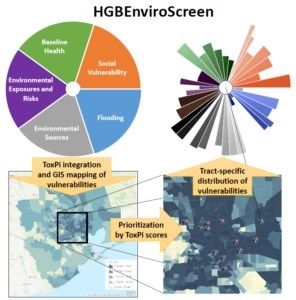
Researchers at the Texas A&M University (TAMU) SRP Center collaborated with the Environmental Defense Fund to develop the HGBEnviroScreen , an interactive map to help communities understand environmental risk factors and identify and prioritize regions of heightened vulnerability. The tool integrates and visualizes data in five domains: social vulnerability, baseline health, environmental exposures and risks, environmental sources, and flooding. TAMU SRP Center researchers found that the areas with highest vulnerability have multiple risk factors, with common drivers being flooding, social vulnerability, and proximity to sources of environmental contamination. According to the researchers, HGBEnviroScreen provides insights for planning, policy, and action to reduce future vulnerability.
Boston University SRP Center researchers developed MapGAM, an open-source R statistical modeling software package, to map how the interaction of multiple exposures can change risk patterns of public health concern. The group has used this package to investigate the spatial relationship of prenatal exposure to chemicals, such as polychlorinated biphenyls (PCBs), with adolescents' risk-taking behaviors and other behaviors for communities living near the New Bedford Harbor Superfund site in Massachusetts. For example, they identified an area of increased ADHD-related behaviors to the west of this site. Their findings highlight the value of using spatial analysis tools to identify patterns of exposure and high-risk populations.
Scientists at the Northeastern University SRP Center found psychosocial stress modified the effects of chemical exposure on gestational length in a cohort of pregnant women in Puerto Rico. They found that associations between exposures and short gestational length were stronger among women experiencing negative life events compared to women with positive life events. According to the authors, the results suggest that stress makes the body more vulnerable to the effects of chemical exposure. The center explores how neighborhood factors, education, sex, and economic resources may modify exposure to chemicals and health outcomes. They employ innovative approaches to engage community members and stakeholders such as YouTube videos, Facebook live seminars, and an online Report Back Platform where study participants can directly access their results and view information on reducing exposures.
In work made possible with the SRP K.C. Donnelly Externship , Northeastern SRP Center trainee Stephani Eick demonstrated that arsenic-exposed Chileans with lower socioeconomic status were more likely to develop diabetes than those with higher socioeconomic status. This study stems from her externship at the University of California, Berkeley SRP Center.
Researchers at the Columbia University SRP Center recently demonstrated a strategy to improve the efficiency of private well testing for arsenic. They previously reported that differences in arsenic exposure are linked to socioeconomic status , however, these differences primarily arise from differing rates of protective action, such as testing well water for arsenic and subsequently treating or avoiding contaminated water. They also found that water treatment systems effectively reduced arsenic water levels and may reduce the likelihood of developing cancer. The center explores exposure to arsenic in private wells, barriers and attitudes to well testing, and methods to improve well testing behavior and its effect on health.
Columbia University SRP Center scientists also reported that arsenic concentrations in drinking water in Southwestern U.S. correctional facilities may be twice as high as those in nearby communities. They noted that incarcerated populations may lack access to alternative drinking sources, such as bottled water. According to the researchers, increased exposure to contaminants may also contribute to observed health risks within the population.
Addressing Local Environmental and Human Health Issues with Communities

University of New Mexico (UNM) SRP Center researchers mapped the environmental health risk of uranium contamination from abandoned mines on the Navajo Nation. The study is an important first step toward informing future epidemiologic studies and ongoing remediation efforts to reduce human exposure to abandoned uranium mine waste. The center works with Navajo Nation communities to understand their concerns and educate community members on the health risks associated with uranium mines.
Local artist-in-residence and UNM SRP Center Research Translation Core member Mallery Quetawki of the Zuni Pueblo works with center researchers to communicate complex environmental health concepts through. Quetawki has created many paintings to translate scientific messages, specifically for Native American communities impacted by uranium mining.
Scientists at the University of California, Davis SRP Center recently reported shared learning, progress, and challenges from the first two years of the Yurok Tribe Environmental Program collaboration, as well as successful tools and methods to increase communication and knowledge exchange with communities. Center grant recipients developed this program in partnership with the Yurok Tribe to evaluate contamination in the Klamath Watershed and seek appropriate remediation strategies. The project facilitates bidirectional capacity building for tribal scientists and researchers by collaborating in data collection and providing training and technologies to monitor contaminants and their effects on human health. For example, three tribal staff participated in training on how to conduct immunoassays for environmental health research. The team presented a poster of preliminary results at the 2019 SRP Annual Meeting.
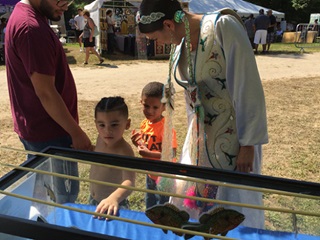
Brown University SRP Center grant recipients partnered with the Narragansett Tribe to facilitate informed decision-making regarding contaminated fish in tribal waters and fish consumption among tribal members. This effort is part of the Namaus (All Things Fish Project) to assess mercury contamination in fish in the reservation's Deep Pond and Schoolhouse Pond. They are investigating contaminants in fish and community activities such as fishing tournaments, youth programs, and information booths at Powwows.
Led by Karletta Chief, Ph.D., researchers at the University of Arizona SRP Center are estimating exposure to arsenic and other metals from mining to develop community engagement tools for Native Americans living near mining sites. The team also builds capacity in communities to protect their food and water sources through workshops, a webinar series, and videos narrated in the Navajo language. Through the center's Native Voices in STEM seminar series, Native scientists and community leaders share their professional journeys to inspire Native students to make positive changes in their community. Recently, Chief highlighted important water research led by Indigenous scientists in tribal communities affected by mining.
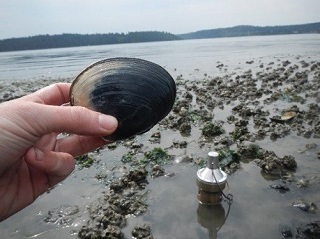
In response to community concerns, researchers at the Oregon State University (OSU) SRP Center, led by Kim Anderson, Ph.D., worked closely with tribal leaders in the Puget Sound region to better predict polycyclic aromatic hydrocarbons (PAHs) levels in butter clams . The team developed a passive sampling model as a sustainable, simple, and accurate approach to predict the concentration of PAHs in clams. In Puget Sound, PAHs are found in the sediment where butter clams are harvested. Butter clams are an important food source and component of cultural practices for local tribes, but PAHs can accumulate in the portion that is edible.
OSU SRP Center researchers also collaborated with the Swinomish Indian Tribal Community to use personal passive sampling wristbands developed with SRP and other NIEHS funding to measure exposure to PAHs. Through this community-based participatory research project, the researchers observed differences in PAH exposure for individuals who participated in different activities or lived at different distances from oil refineries. At the end of the study, participants reported being more aware of their potential exposure to PAHs and felt empowered to take steps to reduce their exposure.
Building Environmental Health Literacy and Engaging with Vulnerable Populations
Translation and communication of research findings is crucial to maximizing the effectiveness of strategies to improve public health. SRP supports innovative communication strategies to make findings more accessible and useful to community members and other stakeholders. The 2020 Strategic Plan (2MB) re-emphasizes the importance of developing connections that accelerate the application of research advances. This requires collaboration with state and local agencies, tribal governments, nonprofit and non-governmental organizations, and communities impacted by hazardous substances.
In a review of environmental health literacy , University of North Carolina at Chapel Hill SRP Center Community Engagement Core leader Kathleen Gray, Ph.D., suggests that the definition of environmental health literacy should explicitly include community change and collective action in response to environmental exposure as a long-term outcome. grant recipients at the center translate research on topics such as well water contamination into knowledge that can improve public health. They build environmental health literacy in North Carolina by partnering with community-based organizations and key stakeholders. Center researchers recently identified opportunities to improve fish consumption advisories to at-risk populations such as subsistence anglers and pregnant and breastfeeding women.
Researchers at the University of Washington SRP Center partner with community groups and state and local agencies to develop strategies to address pollution in the Duwamish River in Seattle. The team created a video series to help inform recreational and subsistence fishers about safe practices. The nine-part series covers the legal and logistical aspects of catching salmon from the Duwamish River, and tips for preparing healthy fish meals. The videos are available in English, Spanish, Vietnamese, and Cambodian.
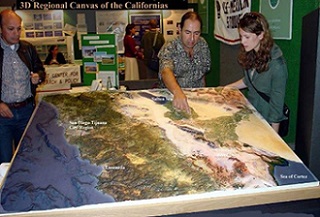
grant recipients at the University of California (UC), San Diego are involved in partnerships to help reduce exposures to hazardous wastes and to improve environmental public health in the San Diego-Tijuana border region. Led by Keith Pezzoli, Ph.D., the initiative builds capacity within vulnerable communities to identify, prioritize, and address Superfund-related environmental health hazards. They launched a series of workshops to bring community leaders and scientists together in a two-way learning experience to explore solutions to environmental health issues.
At the UC San Diego SRP Center, grant recipients also facilitate knowledge exchange between scientists and local communities to improve nutrition and lower health risks in neighborhoods. In a collaborative effort with community groups, the researchers set up a community garden and a neighborhood-based environmental learning center.
University of California, Berkley SRP Center scientists launched the Drinking Water Tool in collaboration with the Community Water Center of Visalia, California. Each year, over one million Californians are exposed to unsafe drinking water in unregulated domestic wells, and vulnerable to harmful contaminants, including arsenic and nitrate. The interactive website helps people in the state identify areas where water quality may be of concern. The information is now being used to evaluate and refine groundwater sustainability plans and to fulfill California's Human Right to Water law.

University of Kentucky SRP Center grant recipients are designing and implementing educational programs and interventions to increase fruit and vegetable consumption among people exposed to PCBs . Many of these programs focus on rural residents of Kentucky and older adults, who may be more susceptible to the harmful effects of hazardous exposures. The team, led by Dawn Brewer, Ph.D., developed a nine-lesson curriculum, "Body Balance: Protect Your Body from Pollution with a Healthy Lifestyle," and partnered with the Kentucky Family and Consumer Sciences Cooperative Extension Service to pilot the curriculum in Kentucky communities. Pre- and post-lesson questionnaires revealed increased knowledge and awareness of the effects of environmental pollutants on health, and the protective role of healthy nutrition . They also showed that older adults significantly increased their fruit and vegetable consumption after participating in the nutrition education lessons.
In Massachusetts, Boston University SRP Center grant recipients partnered with local community working groups to support residents near the New Bedford Harbor Superfund Site in their efforts to reduce exposure to hazardous substances and prevent adverse health outcomes. New Bedford Harbor is home to one of the nation's largest and most contaminated Superfund sites, and its seafloor is polluted with PCBs, making the fish caught in the harbor toxic for consumption . New Bedford is largely a vulnerable community, as PCB contamination spreads over 18,000 acres placing the health and safety of residents at risk.
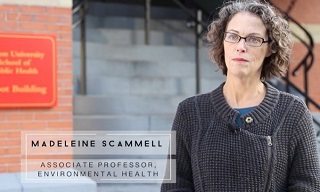
The research team produced a video tour showcasing the history, challenges, and resilience of the community surrounding the New Bedford Harbor Superfund site and SRP-supported research to improve the health and well-being of local residents. In addition to highlighting the social, economic, and environmental value of the harbor to New Bedford and the surrounding communities, the video series is a resource for similar communities and researchers who want to consider the combination of social and environmental health hazards.
The Duke University SRP Center Community Engagement Core launched a mapping tool that shows chemicals tested in communities near formerly contaminated sites, their location, and if they are above or below state health guidelines. In collaboration with community partners in North Carolina, the team led by Elizabeth Shapiro-Garza, Ph.D., develops strategies for reducing and preventing exposures to chemicals from historically contaminated sites. In 2019, they presented their findings during a summit in North Carolina and reflected on lessons learned towards empowering communities and planners to use their research in decision-making.
Scientists at the Baylor College of Medicine SRP Center developed an educational program, the "Prenatal Education on Environmental Exposures during Pregnancy Study," to reduce maternal exposures to toxicants in communities near Superfund sites in Texas. These communities have historically higher rates of preterm birth compared to the national average. In partnership with a community clinic, the researchers are piloting prenatal education classes. With input from community members, the team is also creating curricula translated into multiple languages to educate community members about maternal exposures to harmful pollutants.
Harvard School of Public Health SRP Center researchers use bi-directional communication and citizen science to reduce exposure to metals from Superfund sites in Roxbury, Massachusetts and San Luis Valley, Colorado. The team partners with community members to understand their needs and potential knowledge gaps to develop tools providing practical and useful information they can use to reduce metals exposure. To increase environmental health literacy, they host a speaker series regarding environmental health and community outreach. They also lead a citizen science effort to collect and assess individual exposure from water and soil samples, as well as urine and toenails from pregnant women and children. After identifying houses with high levels of metal, the groups will install water filter technologies to prevent exposure.
Scientists at the Louisiana State University SRP Center , in partnership with communities living near Superfund sites, developed the Louisiana Clean Air Research Engagement for Superfund, a citizen science project to support collective and individual actions to reduce exposure to harmful substances. The project involves community members, including students, in air monitoring and data collection . The team is developing an interactive air-quality website and mobile phone app to share information and research findings. Through this platform, residents will also be able to share their observations regarding air quality. Data will be combined with environmental monitoring to collaborate with communities to design mitigation strategies.
to Top



